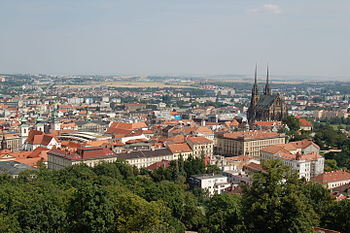Brno
![]()
This article is about the place in Moravia, Czech Republic. For other meanings see Brno (disambiguation).
Brno (Czech Brno ![]() ) is the second largest city in the Czech Republic after Prague, with a population of about 380,000. The city, the historical centre of Moravia since the 17th century, is today the administrative seat of the South Moravian Region (Jihomoravský kraj). Brno has several universities, is an important research location and the seat of the Brno Bishopric of the Roman Catholic Church of the Czech Republic.
) is the second largest city in the Czech Republic after Prague, with a population of about 380,000. The city, the historical centre of Moravia since the 17th century, is today the administrative seat of the South Moravian Region (Jihomoravský kraj). Brno has several universities, is an important research location and the seat of the Brno Bishopric of the Roman Catholic Church of the Czech Republic.
All organs of the highest Czech jurisdiction are located in Brno. These are the Constitutional Court of the Czech Republic (Ústavní soud), the Supreme Court (Nejvyšší soud), i.e. the highest instance of ordinary jurisdiction, the Supreme Administrative Court and the General Prosecutor's Office. The city is also the seat of the Czech Ombudsman and the highest competition authority.
The city has a widely significant position as a strong industrial, commercial, cultural and administrative centre. In a spacious area, the Brno Exhibition Centre in the Pisárky district, several trade fairs important for the Czech economy are held every year.

View of Brno from the Spielberg Fortress
Geography
Location
Brno is located on the southeastern edge of the Bohemian-Moravian Highlands. The Svratka River and the Svitava River, coming from the town of Svitavy, flow through the city and join the Svratka River at the southern city boundary. At the north-western border of the town, the Svratka is dammed into a reservoir Brněnská přehrada, about 9.5 km long and about 600 m wide at its widest point.
The city area is situated at an altitude of 190 - 479 m above sea level. The highest point is Kopeček Hill (479 m above sea level) on the western edge of the city area.
Climate
The average annual temperature is 9.4 °C, the average annual precipitation around 505 mm. The average annual sunshine duration is 1771 hours and there are 150 days with precipitation annually.
| Brno | ||||||||||||||||||||||||||||||||||||||||||||||||
| Climate diagram | ||||||||||||||||||||||||||||||||||||||||||||||||
| ||||||||||||||||||||||||||||||||||||||||||||||||
| Monthly average temperatures and precipitation for Brno
Source: Czech Hydrometeorological Institute (ČHMÚ); wetterkontor.de | ||||||||||||||||||||||||||||||||||||||||||||||||||||||||||||||||||||||||||||||||||||||||||||||||||||||||||||||||||||||||||||||||||||||||||||||||||||||||||||||||||||||||||||||||||||||||||||||||||||||||||||||||||||||||||||||||||||||||||||||||||||||||||||
Language
In addition to Moravian Czech, the city language Hantec, a Czech dialect with a proportion of German loan words, was used in Brno until the 20th century. Until the turn of the millennium, Hantec seemed to fall more and more into oblivion. Since then, the Hantec has again appeared more frequently in local culture and also in everyday interactions.
Before the Second World War, German was the language of larger parts of the upper middle class and also of many Jews in Brno. With the persecution of the Jews by the National Socialists and the flight and expulsion of Germans after the Second World War, the German language almost completely disappeared from the population.
Search within the encyclopedia